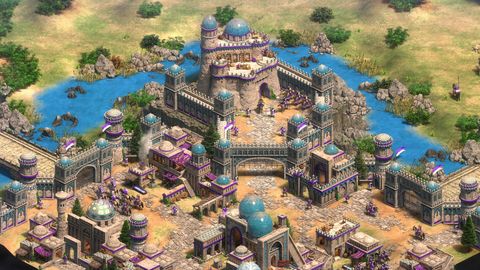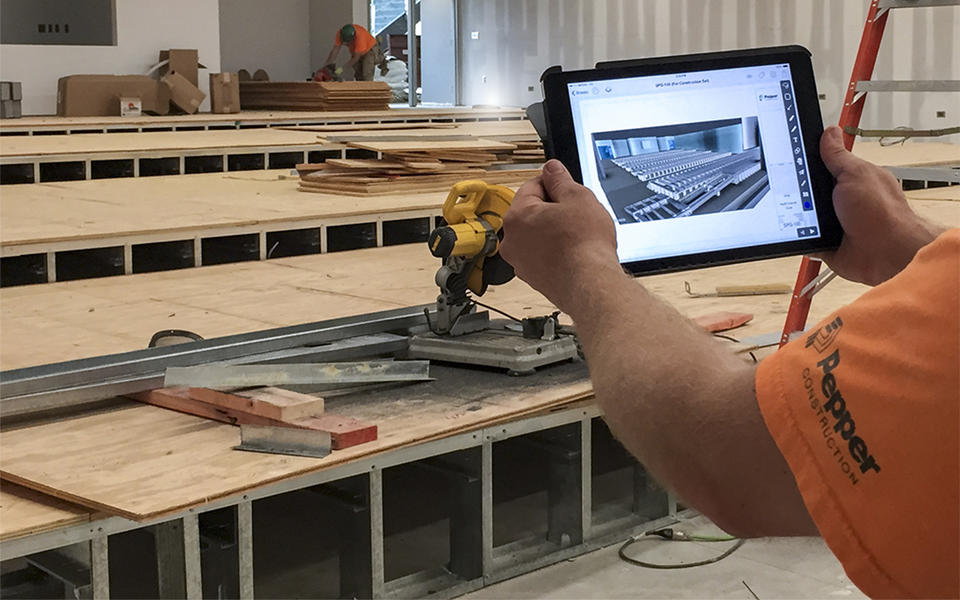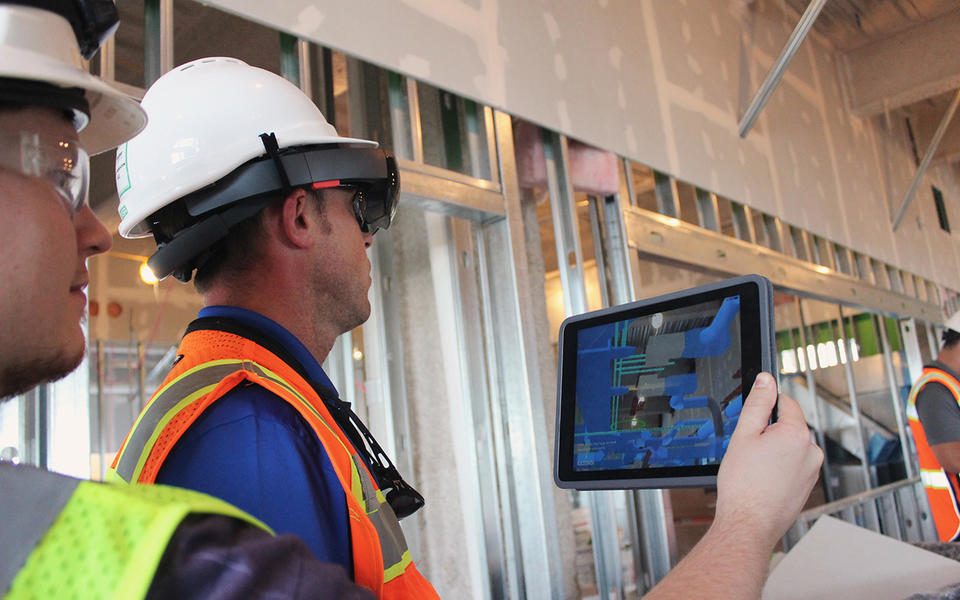UA Local 440 Headquarters & Training CenterVirtual construction & technology
If you're familiar with using Gantt charts for construction schedules, then you know that they extend 15-20 pages long and can be hard to read – overwhelming, in fact. The format encourages tradespeople to look at their own activities and dismiss the rest of the schedule. They may consider the activities that immediately precede them but not those that are contingent on them. It can lead to failure because while the schedule may have been put together with good intentions, it didn't communicate the schedule in an effective way.
In the last few years, pull planning has become instrumental in helping engage our tradespeople in developing and updating our project schedules. It helps tradespeople understand their roles in the overall project and provides for a dynamic way for them to become a part of the scheduling process. However, even with pull planning, it's still easy to miss spatial relationships, logistical challenges and manpower conflicts.
That's where we have been looking to see how 4D scheduling can help.
Although 4D scheduling has been a buzz word in the industry for several years, its use is still in the infancy stage. Throughout our own journey thus far, we've come across our fair share of questions about 4D scheduling.
- What is it?
- What are the benefits and limitations?
- When is it best used?
- What’s next?
We've also encountered challenges along the way as we have sought out implementation of this process.
What is 4D scheduling and how does it work?
4D scheduling is, in simple terms, combining a traditional project schedule with a 3D model of a project to allow you to visually see how the project is planned to be constructed.
Several studies indicate images improve our ability to comprehend information.
- Our brains can see images that last for just 13 milliseconds.
- 90 percent of information transmitted to the brain is visual.
- Images are processed 60x faster than text alone.
- Up to 65% of us are visual learners.
Because of this, there's a huge opportunity to utilize BIM when it comes to visualizing the schedule and comprehending the different activities as they relate to the overall schedule. If a picture is worth a thousand words, it might also be worth a thousand line items on a project schedule.
What we crave from visuals has changed over the years. Project Director Charles Smith compares it to how video games have evolved in the last several decades; the way we have traditionally scheduled our projects in 2D is like the original game of Pacman. It still has its appeal, but keep in mind the younger generations who are now constructing our buildings grew up playing games that are much more advanced and interactive, like Age of Empires or Madden NFL Football.
In construction, we have been using, for all practical purposes, the same software with a few minor updates since Pacman. Pacman came out in May of 1980, about the same time as a company called Micro Planning Services and the UL started running the first PC-based CPM scheduling program on an Apple II called Micro Planner v1.0. We've had very few game changers in our industry until Building Information Modeling. BIM has helped us all communicate complex details, resolve constructability issues and move closer toward real time estimating. But what about our project schedules?
Beyond marketing purposes, what is the real adoption of 4D?
For several years now, our industry has been talking about 4D BIM for scheduling. During the interview process we may show an animated model that moves through the timeline, explaining how the job will be built. That’s 4D scheduling – well, kind-of.
How often does that model get used on the project?
If you take a poll of contractors who have used 4D BIM, all the major construction management firms will raise their hands. If you ask how many use it regularly, more hands will go down. Press further and ask how many have used it from beginning to end on a project and you’ll unmask the reality: not many of us have used it from beginning to end on a single project. And for those who have, we can count them on one or two hands.
4D is most often used in the proposal process to win the job and confirm the baseline schedule, and then maybe it will be pulled out later for problem solving a specific sequence of work.
At Pepper, we look to 4D BIM as a potential solution for scheduling on our projects for several purposes:
- Helping with sequencing
- Confirming the baseline schedule
- Logistics and problem-solving
- Safety planning
- Communicating the plan to the owner
With these potential benefits at hand, why do so few projects utilize 4D scheduling from beginning to end?
Why hasn't our industry fully adopted 4D BIM?
There are several factors that contribute to why the adoption of 4D scheduling has been a challenge for our industry:
- Time/efficiency - Ironically, right now it takes a project team more time to manage a schedule in 4D than it does in traditional 2D platforms.
- Team structure - Because we are adding the model to the process, we immediately introduce a new skillset required to help with the initial setup of the 4D schedule. Most project teams will need the help of a VDC specialist to assist with the initial setup and ongoing updates to the 4D schedule.
- Traditional schedule updates - Changes happen on every project. Even weather impacts can mean re-working the schedule. Though the relationships that are established in the technology upfront should translate through when dates change, the reality is the solutions the team comes up with typically involve re-working those relationships and sequence of activities to gain back the time. Oftentimes, our challenge with keeping a 4D schedule current has nothing to do with 4D at all, but rather with our approach toward traditional scheduling.
- Pull Plan schedules - It can be challenging to integrate the pull plan efficiently with a 4D model. Currently, many of the traditional scheduling platforms that integrate with our 4D schedules don't account for pull planning, and the software that does integrate with pull planning, isn't integrated with our 4D platforms. Further, often, pull plans are physically maintained on the wall. Therefore, maintaining a 4D model on a project with pull planning can be challenging and potentially create duplicate work, which isn't lean.
- Level of detail – Once 4D is introduced to a project and the owner sees the model come to life, often they want more information to be shown graphically. That may require more detail (line items) in the schedule than we originally intended. Finding the right balance between what different parties need to see in the schedule is often the challenge when getting started.
How to use 4D BIM during construction
At Pepper, we've used 4D to help manage the schedule on three projects. So far we've used it on UA Local 440's new headquarters and training facility in Indianapolis, the Indiana University Foster Hall renovation project in Bloomington, Indiana, and the recently-opened Columbia College Student Center in Chicago.
We're still figuring it out, but we've seen it help our teams develop, analyze and communicate the schedule. From our experience so far, we can offer three tips to get started and make each consecutive project more successful than the last.
01. Find the right project.
At Pepper, we don't have schedulers. Our project teams develop the schedules, and that gives us an advantage when it comes to managing a 4D schedule. The 4D is only as good as the 2D, and when the entire team is part of the original plan and actively involved in maintaining it, the schedule retains its validity.
For example, the Columbia College project had a unique situation where the visualization became invaluable and motivated us to maintain the 4D schedule. Since the Chicago Transit Authority (CTA) train tracks ran along the edge of our site, we needed to minimize our time along that edge. The train schedule and our team's safety were at stake. The 4D model helped clearly explain our approach to our structural trade partners, which helped us avoid miscommunication during and after planning. It also became a communication tool with the CTA, who had requested regular project updates for their internal meetings. They needed to maintain a close pulse on what activities would be going on and when. Instead of creating both a 2D schedule and a logistics plan and keeping both updated, our team created a 4D schedule.
All of the projects on which we've used 4D benefited from the process and had teams that were willing to try something new. The two recent projects in Indiana were both led by Project Director Charles Smith. He sees the technology's potential and is willing to work on it, and the entire team was willing to try new workflows and provide feedback to help improve the process.
"I've seen good ideas not take off because the idea didn't keep up with the technology or maybe we didn't understand the intended purpose so we gave up on it. This is something I believe we have to figure out. In the development process, it's going to start off clunky. Just like computer coding started out, there isn't a short-cut to a keystroke. We may have to type in some long code, but that will change soon. We have people spending the time to understand it, and we're starting to see results."
Charles Smith
Project Director
02. Coordinate with the Lean plan.
As mentioned above, one of the challenges with implementing a 4D schedule is figuring out how to make it work with the pull plan. To figure that out, our team turned to Operations Improvement Leader Heather Siemers for help.
Depending on the team, we could be asking them to create three schedules: a traditional 2D milestone schedule (CPM), the pull plan and the 4D. For UA Local 440 , we decided to create and maintain our only digital schedule in Synchro. We kept the pull plan with the sticky notes because the trades benefit from the process. Every week we held the pull plan update meeting with the trades, and then every two weeks we updated the schedule in Synchro. Because the six-week look-ahead schedules and pull planning kept the schedule on track, updates in Synchro were required less often.
Like every project, we had weather delays. To handle those changes, we held off making the changes in Synchro until we figured it out in the pull plan.
"4D aligns with the Lean principle of increased visualization. When we had to make changes because of weather delays, we could visually compare the original to the updated version - to see where we were supposed to be and where we were at that time - and look for opportunities to get back on track. It clearly showed us the real impact and allowed us to adjust the sequencing."
Heather Siemers
Operations Improvement Leader
03. Customize the process.
It's an entirely different perspective to use BIM as the scheduling tool. It involves different strategies, different resources and a different level of effort and thought. Here are some questions worth considering to help you customize the process for your project:
- Who is the project team champion for scheduling?
- What activities do you want to see represented visually in the 4D schedule?
- To what level of detail do you want to break down each activity? (by floor, by area, by component)
- What are you hoping to achieve by doing a 4D schedule?
- How will you keep the process going when changes and challenges arise?
At IU, we've used 4D in a different way. Foster Hall encompasses five buildings. Four are four-stories tall and one is a 10-story building, which means we're working on more than 30 floors and 1,000 rooms. With 100 people spread across the site, walking around the job, you may only see 10 people. Some activities start in the basement and work up; others start at the top and work down. Still others are working on the envelope.
There are 7-10 activities that are repeated in each room (i.e. mechanical, electrical, ceilings, paint, flooring, etc.). Rather than 4D scheduling the individual model components that make up those systems, we scheduled the 3D room geometry and color coded it by task. 4D allows the team to see all 5 buildings at once, and with the isometrics the electrician can quickly see where people are located. Essentially, it provides a live image where tradespeople can pick a moment in time and see where they'll be.
"The rooms are too small for people to be working side by side, so we follow a sequence and pattern. When you look at the schedule in 2D, there is a lot to digest. It's too much data. The goal with a 4D schedule was to graphically depict where we need to be moving people and who is going ahead of whom in a visual way."
Charles Smith
Project Director
What’s next and why it's worth persevering
At the end of the day, 4D scheduling is a tool to make us work better together. As Charles put it:
We have learned a lot from our first few projects. From our experience we have identified the key criteria for the success of 4D and have seen the benefits we anticipated begin to play out. With several more projects lined up to utilize this technology, we continue to push forward in our use and implementation.
Our industry can be slow to adapt, but we believe overcoming initial hiccups will be worth it for everyone. In the future, big data and Artificial Intelligence will continue to change the game of scheduling. Instead of developing a schedule, our teams will enter the project parameters, and it will give us options. In fact, versions of that technology are already here, and our team is at the forefront of exploring them. That's why we press on to figure out the workflows and team structure as we continue to use it on more projects. We want to be prepared to take advantage of the technologies that will eventually bring even more advantages to our teams and our projects.
If you're interested in learning more about big data and AI, I encourage you to follow us. We'll share what we learn along the way. You can also catch Vice President of Technical Services Jennifer Suerth speaking on relevant technology topics at the Chicago Construction Expo and Safety Conference in March and later at BuiltWorlds in May.
About the Author













